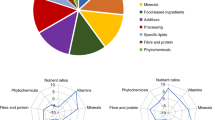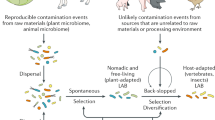Abstract
During the last 6 y, the European Union has undergone a profound qualitative change in the focus on food safety problems. In 1997, nine new scientific committees were created, including the Scientific Committee on Food (SCF) and the Scientific Steering Committee (SSC), and were put under the auspices of the Directorate General in charge of defending consumer interests and health. The process is foreseen to be completed by the incorporation in 2003 of all food safety activities of these committees into the European Food Safety Authority (EFSA).
Among the immediate challenges in the near future are the scientific and technological developments and the regulatory measures for the so-called ‘functional foods’, which can positively affect the health and well-being of consumers. Functional foods are a recent phenomenon in Europe and are, as yet, not covered by any specific legislation. The two key aspects in the evaluation of functional foods are safety and efficacy. Whereas safety can be covered under different legislative umbrellas such as novel foods (NFs), foods for particular nutritional purposes, supplements, additives and others, the issue of evaluation of their efficacy is only at a very early stage since the criteria to establish the validity of ‘health claims’ has not been clearly addressed at a European level.
This is a preview of subscription content, access via your institution
Access options
Subscribe to this journal
Receive 12 print issues and online access
$259.00 per year
only $21.58 per issue
Buy this article
- Purchase on Springer Link
- Instant access to full article PDF
Prices may be subject to local taxes which are calculated during checkout
Similar content being viewed by others
References
Amundsen AL, Ose L, Nenseter MS & Ntanios FY (2002): Plant sterol ester-enriched spread lowers plasma total and LDL cholesterol in children with familial hypercholesterolemia. Am. J. Clin. Nutr. 76, 338–344.
Arai S, Morinaga Y, Yoshikawa T, Ichiishi E, Kiso Y, Yamazaki M, Morotomi M, Shimizu M, Kuwata T & Kaminogawa S (2002): Recent trends in functional food science and the industry in Japan. Biosci. Biotechnol. Biochem. 66, 2017–2029.
Bellisle F (2002): Functional foods in Europe: designing foods for the prevention and treatment of obesity. In: eds. A Palou, M L Bonet, F Serra, Study on ‘Obesity and Functional Foods in Europe’, pp 293–301. Luxembourg: European Communities. ISBN 92-894-4292-1.
Bellisle F, Blundell JE, Dye L, Fantino M, Fern E, Fletcher RJ, Lambert J, Roberfroid M, Specter S, Westenhofer J & Westerterp-Plantenga MS (1998): Functional food science and behaviour and psychological functions. Br. J. Nutr. 80(Suppl 1), S173–S193.
CEE (2000): White paper on Food Safety. COM 1999/0719 Final, 52.
Contor L (2001): Functional Food Science in Europe. Nutr. Metab. Cardiovasc. Dis. 11, 20–23.
Daniel H (2002): Genomics and proteomics: importance for the future of nutrition research. Br. J. Nutr. 87(Suppl 2), S305–S311.
Diplock AT, Aggett PJ, Ashwell M, Bornet F, Fern EB & Roberfroid MB (1999): Scientific concepts of functional foods in Europe Consensus document. Br. J. Nutr. 81 (Suppl 1), S1–S27.
EC (1995): European Parliament and Council Directive No. 95/2/EC of February 1995 on food additives other than colours and swaeteners. Off. J. Eur. Communities L061, 1–40.
EC (1997a): 97/618/EC: Commission Recommendation of 29 July 1997 concerning the scientific aspects and the presentation of information necessary to support applications for the placing on the market of novel foods and novel food ingredients and the preparation of initial assessment reports under Regulation (EC) No. 258/97 of the European Parliament and of the Council. Off. J. Eur. Communities L253, 1–36.
EC (1997b): Commission Decision No. 97/404/EC of 10 June 1997 setting up a Scientific Steering Committee. Off. J. Eur. Communities L169, 85–87.
EC (1997c): Commission Decision No. 97/579/EC of 23 July 1997 setting up Scientific Committees in the field of consumer health and food safety. Off. J. Eur. Communities L237, 18–23.
EC (1997d): Regulation (EC) No. 258/97 of the European Parliament and of the Council of 27 January 1997 concerning novel foods and novel food ingredients. Off. J. Eur. Communities L43, 1–7.
EC (2000): Directive 2000/13/EC of the European Parliament and of the Council of 20 March 2000 on the approximation of the laws of the Member States relating to the labelling, presentation and advertising of foodstuffs. Off. J. Eur. Communities L109, 29–42.
EC (2002a): Directive 2002/46/EC of the European Parliament and of the Council of 10 June 2002 on the approximation of the laws of the Member States relating to food supplements. Off. J. Eur. Communities L183, 51–57.
EC (2002b): Regulation (EC) No. 178/2002 of the European Parliament and of the Council of 28 January 2002 laying down the general principles and requirements of food law, establishing the European Food Safety Authority and laying down procedures in matters of food safety. Off. J. Eur. Communities L31, 1–24.
Eckhardt RB (2001): Genetic research and nutritional individuality. J. Nutr. 131, 336S–339S.
EEC (1989): Council Directive 89/398/EEC of 3 May 1989 on the approximation of the laws of the Member States relating to foodstuffss intended for particular nutritional uses. Off. J. Eur. Communities L186, 27–32.
EEC (1990): Council Directive 90/496/EEC of 24 September 1990 on nutrition labelling for foodstuffs. Off. J. Eur. Communities L276, 40–44.
Hallikainen MA, Sarkkinen ES & Uusitupa MI (2000): Plant stanol esters affect serum cholesterol concentrations of hypercholesterolemic men and women in a dose-dependent manner. J. Nutr. 130, 767–776.
Hasler CM (2002): Functional foods: benefits, concerns and challenges—a position paper from the American Council on Science and Health. J. Nutr. 132, 3772–3781.
Hasler CM, Kundrat S & Wool D (2000): Functional foods and cardiovascular disease. Curr. Atheroscler. Rep. 2, 467–475.
Kwak NS & Jukes DJ (2001): Functional foods. Part 2: The impact on current regulatory terminology. Food Control 12, 109–117.
Milner JA (1999): Functional foods and health promotion. J. Nutr. 129, 1395S–1397S.
Ntanios FY & Duchateau GS (2002): A healthy diet rich in carotenoids is effective in maintaining normal blood carotenoid levels during the daily use of plant sterol-enriched spreads. Int. J. Vitam. Nutr. Res. 72, 32–39.
OECD (1993): Safety evaluation of foods derived by modern biotechnology: Concept and principles. http://www.oecd.org/pdf/M00033000/M00033002.pdf
Palou A, Bonet ML & Serra F (eds) (2002): Study on ‘Obesity and Functional Foods in Europe’. Luxembourg: European Communities. ISBN 92-894-4292-1.
Palou A, Picó C & Bonet M.L . (2003): Food safety and functional foods in the European Union. Obesity as a paradigmatic example for novel food development. Nutr. Rev. (in press).
Roberfroid MB (2000): A European consensus of scientific concepts of functional foods. Nutrition 16, 689–691.
SANCO (2001): Discussion paper on ‘Nutrition claims and functional claims’. SANCO/1341/2001. http://europa.eu.int/comm/dgs/health_consumer/index_en.htm.
SCF (2000): Opinion of the SCF on a request for the safety assessment of the use of phytosterol esters in yellow fat spreads. SCF/CS/NF/DOS/1 Final.
SCF (2002a): General view of the Scientific Committee on Food on the long-term effects of the intake of elevated levels of phytosterols from multiple dietary sources, with particular attention to the effects on β-carotene. SCF/CS/NF/DOS/20 ADD 1 Final.
SCF (2002b): Opinion of the Scientific Committee on Food on a report on Post Launch Monitoring of ‘yellow fat spreads with added phytosterol esters’. SCF/CS/NF/21 ADD 2 Final.
Weststrate J (2000): Functional foods: cholesterol-lowering benefits of plant sterols. Br. J. Nutr. 84, 253.
WHO/FAO (2000): Safety aspects of genetically modified foods of plant origin. Report of a joint FAO/WHO expert consultation on foods derived from biotechnology, 29 May–2 June.
Author information
Authors and Affiliations
Contributions
Contributors: The order in which the contributors are listed is agreed among the investigators, and indicates that the first author (A Palou) has made the greatest contribution, consisting of designing the schedule of the publication and writing the preliminary version, and the second and third authors (F Serra and C Pico) have equally contributed to the work in writing the definitive version.
Corresponding author
Rights and permissions
About this article
Cite this article
Palou, A., Serra, F. & Pico, C. General aspects on the assessment of functional foods in the European Union. Eur J Clin Nutr 57 (Suppl 1), S12–S17 (2003). https://doi.org/10.1038/sj.ejcn.1601822
Published:
Issue Date:
DOI: https://doi.org/10.1038/sj.ejcn.1601822
Keywords
This article is cited by
-
Postbiotic metabolites produced by Lactobacillus plantarum strains exert selective cytotoxicity effects on cancer cells
BMC Complementary and Alternative Medicine (2019)



